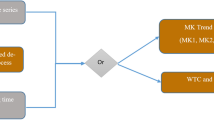Abstract
Rainfall forecasting and approximation of its magnitude have a huge and imperative role in water management and runoff forecasting. The main objective of this paper is to obtain the relationship between rainfall time series achieved from wavelet transform (WT) and moving average (MA) in Klang River basin, Malaysia. For this purpose, the Haar and Dmey WTs were applied to decompose the rainfall time series into 7, 10 different resolution levels, respectively. Several preprocessing case studies based on 2-, 3-, 5-, 10-, 15-, 20-, 25-, and 30-month MAs were carried out to discover a longer-term trend compared to a shorter-term MA. The information and data were gathered from Klang Gates Dam, Malaysia, from 1997 to 2008. Regarding the behavior, the time series of 10-, 15-, 20-, and 30-day rainfall are decomposed into approximation and details coefficient with different kind of WT. Correlation coefficient R 2 and root-mean-square error criteria are applied to examine the performance of the models. The results show that there are some similarities between MA filters and wavelet approximation sub-series filters due to noise elimination. Moreover, the results obtained that the high correlation with MAs can be achieved via Dmey WT compared to Haar wavelet for rainfall data. Moreover, clean signals could be used as model inputs to improve the model performance. Therefore, signal decomposition techniques for the purpose of data preprocessing could be favorable and could be appropriate for elimination of the errors.





Similar content being viewed by others

References
Akrami SA, Nourani V, Hakim SJS (2014) Development of nonlinear model based on wavelet-ANFIS for rainfall forecasting at Klang Gates Dam. Water Resour Manag 28(10):2999–3018
Cannas B, Fanni A, See L, Sias G (2006) Data preprocessing for river flow forecasting using neural networks: wavelet transforms and data partitioning. Phys Chem Earth 31:1164–1171
Chang FJ, Chen L (1998) Real coded genetic algorithm for rule-based flood control reservoir management. Water Resour Manag 12(3):185–198
Chen GY, Bui TD, Krzyzak A (2009) Invariant pattern recognition using radon, dual-tree complex wavelet and Fourier transforms. Pattern Recogn 42:2013–2019
Chen RJC, Bloomfield P, Fu JS (2003) An evaluation of alternative forecasting methods to recreation visitation. J leis Res 35(4):441–454
Earth Observation Centre, Universiti Kebangsaan Malaysia (UKM), Malaysia 2013
Fonseca ES, Guido RC, Scalassara PR (2007) Wavelet time–frequency analysis and least squares support vector machines for the identification of voice disorders. Comput Biol Med 37:571–578
Fu Y, Serrai H (2011) Fast magnetic resonance spectroscopic imaging (MRSI) using wavelet encoding and parallel imaging: in vitro results. J Magn Reson 211:45–51
Genovese L, Videaud B, Ospici M, Deutschd T, Goedeckere S, Méhaut JF (2011) Daubechies wavelets for high performance electronic structure calculations. CR Mec 339:149–164
Lisi F, Nicolis O, Sandri M (1995) Combining singular-spectrum analysis and neural networks for time series forecasting. Neural Process Lett 2(4):6–10
Maier HR, Dandy GC (2000) Neural networks for the prediction and forecasting of water resources variables: a review of modeling issues and applications. Environ Model Softw 15:101–123
Mallat SG (1998) A wavelet tour of signal processing. Academic Press, San Diego
Masset P (2008) Analysis of financial time-series using Fourier and Wavelet Methods, University of Fribourg (Switzerland)—Faculty of Economics and Social Science
Newbold P, Carlson WL, Thorne BM (2003) Statistics for business and economics (fifth version). Prentice Hall, Upper Saddle River
Nourani V, Komasi M, Mano A (2009) A multivariate ANN-wavelet approach for rainfall-runoff modeling. Water Resour Manag 23:2877–2894
Partal T, Kisi O (2007) Wavelet and neuro-fuzzy conjunction model for precipitation forecasting. J Hydrol 342:199–212
Rioul O, Vetterli M (1991) Wavelets and signal processing. IEEE SP Magazine. pp 14–38
Serrai H, Senhadji L (2005) Acquisition time reduction in magnetic resonance spectroscopic imaging using discrete wavelet encoding. J Magn Reson 177:22–30
Shafiekhah M, Moghaddam MP, Sheikh El Eslami MK (2011) Price forecasting of day-ahead electricity markets using a hybrid forecast method. Energy Convers Manag 52:2165–2169
Sifuzzaman M, Islamand MR, Ali MZ (2009) Application of wavelet transform and its advantages compared to fourier transform. J Phys Sci 13:121–134
Syed AR, Aqil B, Badar S (2010) Forecasting network traffic load using wavelet filters and seasonal autoregressive moving average model. Int J Comput Electr Eng 2(6):1793–8163
Wu CL, Chau KW, Li YS (2009) Methods to improve neural network performance in daily flows prediction. J Hydrol 372:80–93
Yang X, Ren H, Li B (2008) Embedded zero tree wavelets coding based on adaptive fuzzy clustering for image compression. Image Vis Comput 26:812–819
Zhao X, Ye B (2010) Convolution wavelet packet transform and its applications to signal processing. Digit Signal Process 20:1352–1364
Acknowledgments
I am deeply indebted to Dr. Akrami and Dr.Fakheri Fard from University Of Tabriz for their encouragement and guidance throughout this paper.
Author information
Authors and Affiliations
Corresponding author
Rights and permissions
About this article
Cite this article
Akrami, S.A., El-Shafie, A., Naseri, M. et al. Rainfall data analyzing using moving average (MA) model and wavelet multi-resolution intelligent model for noise evaluation to improve the forecasting accuracy. Neural Comput & Applic 25, 1853–1861 (2014). https://doi.org/10.1007/s00521-014-1675-0
Received:
Accepted:
Published:
Issue Date:
DOI: https://doi.org/10.1007/s00521-014-1675-0



